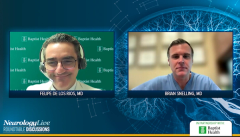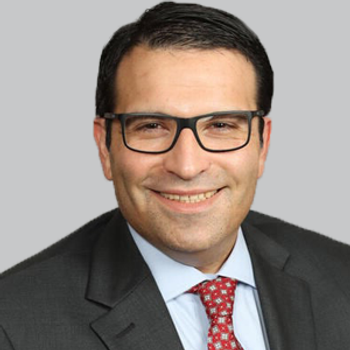
Expanding Eligibility for Thrombectomy

In this kickoff episode, Drs. Brian Snelling, MD, and Felipe De Los Rios, MD, discussed how evolving evidence continues to expand mechanical thrombectomy eligibility, from extended time windows to large-core and medium-vessel occlusions. [WATCH TIME: 6 minutes]
WATCH TIME: 6 minutes
Across the evolving landscape of stroke treatment, advancements in imaging, intervention, and digital technology continue to redefine what is possible for patients. In this special panel discussion series, neurosurgeon Brian Snelling, MD, and neurologist Felipe De Los Rios, MD, share their expertise from
Over five focused conversations, they discuss the major shifts shaping acute stroke management—from expanding thrombectomy eligibility and integrating artificial intelligence into clinical workflows, to the promise of neuroprotective agents, modern strategies for recovery and prevention, and the optimization of stroke systems of care. Together, their insights provide an inside look at how data-driven innovation is transforming outcomes for patients across every stage of stroke treatment.
In this opening conversation, the duo discuss how evolving evidence continues to expand mechanical thrombectomy eligibility. Snelling, director of cerebrovascular and endovascular neurosurgery, and director of the stroke program at Marcus Neuroscience Institute, spoke on the historical progression of thrombectomy, covering landmark trials from 2015 to 2018, and how subsequent studies redefined what constitutes a treatable stroke. De Los Rios, neurologist, Irma Bass Endowed Chair in Stroke Neurology, and director of the stroke program at Baptist Health, provided key insights about evolving guidelines, trial inclusion criteria, and the challenges of addressing functional baseline in acute settings.
Transcript was edited for clarity.
Brian Snelling, MD: In 2015, we saw five large randomized trials demonstrating clear benefit for mechanical thrombectomy in patients with intracranial large-vessel occlusions, mainly M1 or ICA terminus lesions. Those studies didn’t really address more distal occlusions or extended time windows. Around 2018, newer trials expanded that time window and introduced perfusion imaging as a way to identify patients with salvageable brain tissue—further widening the population we could treat.
Since then, our focus has shifted to understanding which patients we may still be leaving out. The next major question involved those with large cores or low ASPECTS scores—essentially, patients showing more extensive early ischemic changes on CT. Trials like SELECT2, TESLA, and ANGEL-ASPECT investigated these populations, and most demonstrated a clear benefit for thrombectomy in large-core strokes, even up to 24 hours after onset.
Most recently, attention has turned to medium-vessel (MeVO) or distal occlusions—those beyond the M1 segment or in smaller branches of the anterior and posterior circulation. Several 2025 studies, such as ESCAPE-MeVO, DISTAL, and DISCOUNT, examined this question. Overall, they didn’t show added benefit over best medical therapy, and some even reported higher rates of intracranial hemorrhage.
However, many of us see potential flaws in those data. These trials primarily used stent retrievers as first-line devices, whereas aspiration techniques—especially with newer, smaller catheters—may be safer and more effective for fragile, distal vessels. Patient selection is another concern; many enrolled had lower NIHSS scores or were excluded if symptoms weren’t deemed “severe enough.” So, while the first wave of MeVO trials didn’t meet endpoints, we believe there’s still more to explore, particularly for patients with disabling deficits like isolated aphasia or hemiparesis due to M2 or M3 occlusions.
Felipe De Los Rios, MD: Those are excellent points, and this truly remains a rapidly evolving field. We all want to extend therapy to more patients, since stroke is such a disabling condition. Several large-core trials have now led to scientific advisories from organizations such as the AHA and various endovascular societies—those are available online and outline guidance for clinicians.
Most of these trials recruited patients with ASPECTS as low as 3, with TESLA including some just below that. But for those with scores of 0 to 2, we still don’t have clear data on benefit. These studies also tended to include patients who were functionally independent before stroke—usually with an mRS of 0 or 1. It’s harder to know how to approach patients who start with mild pre-stroke disability, especially when that disability isn’t neurologic, like orthopedic limitations.
Establishing a true functional baseline in the acute setting can be difficult, and frailty plays a big role in outcomes. So while the science supports expanding eligibility, we still have practical and ethical challenges in deciding who truly benefits.
Brian Snelling, MD: Right, and for us, that lower threshold—ASPECTS of around 3—is about as far as we’ll go, particularly since we participated in TESLA and rely on those parameters. That said, we often still obtain perfusion imaging for these patients, which can help refine selection beyond what noncontrast CT shows.
There’s also new data on using perfusion imaging to extend the window for thrombolytics. For example, the TRACE-3 trial out of China treated patients with alteplase up to 24 hours from onset if they had a favorable perfusion profile—a small core and significant penumbra. It raises an interesting question: could some distal or medium-vessel occlusions respond well to late-window thrombolytics rather than thrombectomy, which carries more risk in those vessels?
Felipe De Los Rios, MD: Exactly. It’s possible that for certain patients—those with smaller clot burdens or more distal occlusions—thrombolysis could offer safer and faster recanalization. We’re really at the edge of what both therapies can offer. The next few years will likely bring more clarity as we refine patient selection and optimize timing for each approach.
Newsletter
Keep your finger on the pulse of neurology—subscribe to NeurologyLive for expert interviews, new data, and breakthrough treatment updates.



































